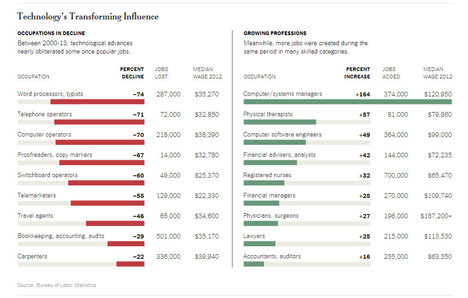 Source of graph: online version of the NYT article quoted and cited below.
Source of graph: online version of the NYT article quoted and cited below.
(p. 4) JUST over 50 years ago, the cover of Life magazine breathlessly declared the “point of no return for everybody.” Above that stark warning, a smaller headline proclaimed, “Automation’s really here; jobs go scarce.”
As events unfolded, it was Life that was nearing the point of no return — the magazine suspended weekly publication in 1972. For the rest of America, jobs boomed; in the following decade, 21 million Americans were added to the employment rolls.
Throughout history, aspiring Cassandras have regularly proclaimed that new waves of technological innovation would render huge numbers of workers idle, leading to all manner of economic, social and political disruption.
As early as 1589, Queen Elizabeth I refused a patent on a knitting machine for fear it would put “my poor subjects” out of work.
In the 1930s, the great John Maynard Keynes predicted widespread job losses “due to our discovery of means of economising the use of labour outrunning the pace at which we can find new uses for labour.”
So far, of course, they’ve all been wrong. But that has not prevented a cascade of shrill new proclamations that — notwithstanding centuries of history — “this time is different”: . . .
For the full commentary, see:
Steven Rattner. “Fear Not the Coming of the Robots.” The New York Times, SundayReview Section (Sun., JUNE 22, 2014): 4.
(Note: ellipsis added.)
(Note: the online version of the commentary has the date June 21, 2014.)

